Tibial tubercle-to-trochlear groove distance: Is it the best tool for the job?
The surgical community has long struggled with the concept of bony malalignment in the setting of patellofemoral instability. Authors agree that a subset of patients who have recurrent instability should undergo realignment of the extensor mechanism because simple soft tissue stabilization is doomed to failure in the setting of excessive malalignment. However, the specific definition of bony malalignment in the setting of patellofemoral instability has been somewhat elusive.

Jacqueline Munch

Jaron Sullivan

Beth Shubin Stein
The “Q angle” was devised as a method of measuring the degree of valgus about the patellofemoral joint, but problems with low inter-rater variability were noted. These were thought to be related to positioning of the patient and the limb, contraction of the quadriceps, and identification of bony landmarks during the measurement. The tibial tubercle–to trochlear groove (TT-TG) distance, as measured on axial cross-sectional imaging of the knee, was proposed as a more reproducible adjunct to the Q angle (Figure 1).
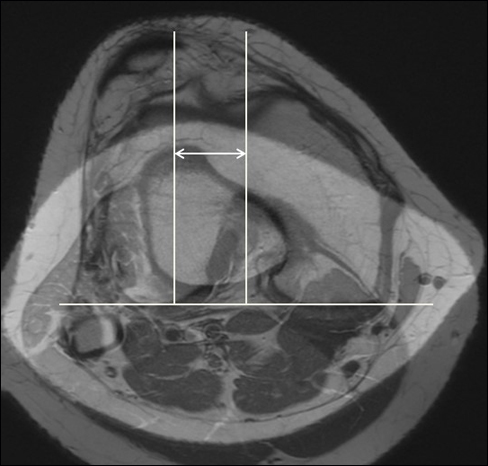
Figure 1. Shown is TT-TG measurement on axial MRI.
Source: Munch J
Originally proposed for measurement on axial CT, the TT-TG has since been validated for use with MRI. The measurement is made parallel to the posterior condylar line of the femur. In the literature, the tibial tubercle has been measured at the center of the bony tubercle on CT scan, and at the center of the patellar tendon insertion on MRI. Likewise, the trochlear groove can be measured caudally, at the deepest portion of the trochlear groove, or cranially, at the most proximal extent of the complete cartilaginous trochlea. Figure 2 demonstrates the caudal and cranial trochlear groove measurements for the same patient’s knee MRI.
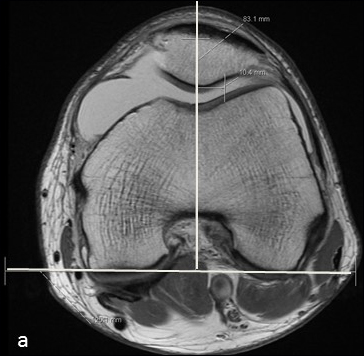
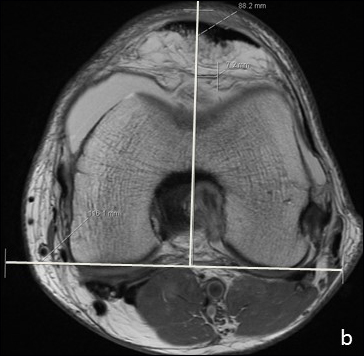
Figure 2. Caudal slice for measurement of trochlear groove: most distal portion of the trochlea with an intact “Roman arch” of the intercondylar notch (a). Cranial slice for measurement of trochlear groove: most proximal portion of the trochlea with a complete cartilaginous trochlea (b).
Source: Munch J
As our treatment options have improved for patellofemoral instability and its related injuries, interest has grown in categorizing patients into two groups: 1) patients who require only soft tissue repair/reconstruction, and 2) patients who require bony realignment, such as tibial tubercle osteotomy for definitive stabilization. Dejour and colleagues recommended a TT-TG threshold of 20 mm as an indication for bony realignment. However, to date, no clinical outcomes studies to our knowledge corroborate that recommendation. In addition, several unrelated factors have been found to cause changes in the TT-TG, including knee flexion and alignment of the axial series during MRI acquisition and analysis. Figure 3 and Figure 4 demonstrate these changes.
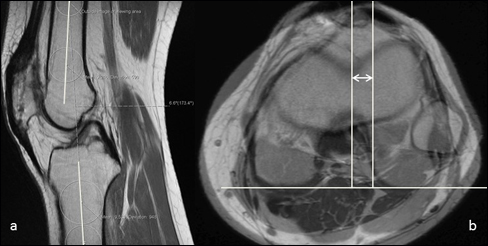
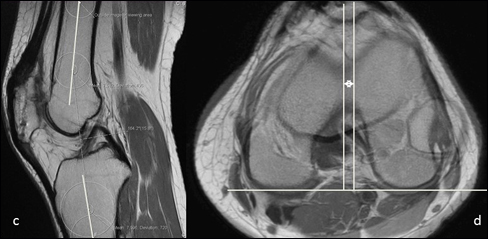
Figure 3. Sagittal image depicts the knee in approximately 7° of resting flexion during MRI (a). Superimposed axial images of the same MRI, demonstrate a TT-TG distance of 16 mm (white arrow) (b). Sagittal image from an MRI of the same patient’s knee, 9 months later, demonstrates approximately 16° of resting knee flexion (c). Superimposed axial images of the same, second MRI, demonstrate a TT-TG distance of 9 mm (white arrow) (d).
Source: Munch J
In Figure 3, a single patient underwent two separate knee MRIs at the same institution, with 9 months intervening. The TT-TG was altered in the setting of different degrees of knee flexion: the tibia internally rotates with knee flexion, so the TT-TG is reduced. In Figure 4, adjustments of the axis of the axial series in a single MRI change the TT-TG dramatically, taking this patient from less than 20 mm (no bony realignment indicated) to greater than 26 mm (bony realignment indicated).
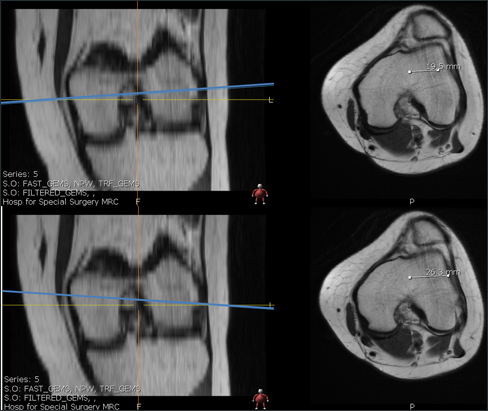
Figure 4. Manipulation of the axis of MRI axial series acquisition (left side, blue line) causes changes to the TT-TG (right side, white line). Note that the patient does not qualify for bony realignment on the top image, but manipulation of the axis on the bottom image increases the TT-TG past the 20 mm threshold for tibial tubercle osteotomy.
Source: Munch J
Based on the current literature, the TT-TG is not a completely foolproof indicator for bony realignment vs. soft tissue repair/reconstruction. Normal anatomical variation of the TT-TG measurement will be unknown until we standardize knee flexion, weight bearing and axial image orientation during data collection. The TT-TG should therefore be used with caution when making clinical decisions. It may, however, provide a useful tool when combined with other patient factors such as patella alta, trochlear dysplasia, skeletal maturity, ligamentous laxity and cartilage injury. High quality clinical studies are needed to determine the specific role of the TT-TG measurement in surgical decision-making for the treatment of recurrent patellofemoral instability.
References:
Ando T. Clin Orthop Relat Res. 1993;289:213-219.
Biedert RM, Gruhl C. Arch Orthop Trauma Surg. 1997;116(1-2):77-82.
Brattstrom H. Acta Orthop Scanda. 1970;41(5):578-588.
Dejour H. Knee Surg Sport Tramatol Arthrosc. 1994;2:19-26.
France L. Clin Biomech. 2001;16(8):710-713.
Guerra JP. J Orthop Sports Phys Ther. 1994;doi:10.2519/jospt.1994.19.4.200.
Izadpanah K. Knee Surg Sports Traumatol Arthrosc. 2013;doi:10.1007/s00167-013-2537-5.
Schoettle PB. Knee. 2006;13:26-31.
Yao L. AJR Am J Roentgenol. 2014;doi:10.2214/AJR.13.11488.
Jacqueline Munch, MD, Jaron Sullivan, MD, and Beth Shubin Stein, MD, are from the Hospital for Special Surgery in New York City.
Disclosures: Munch, Sullivan and Shubin Stein have no relevant financial disclosures.